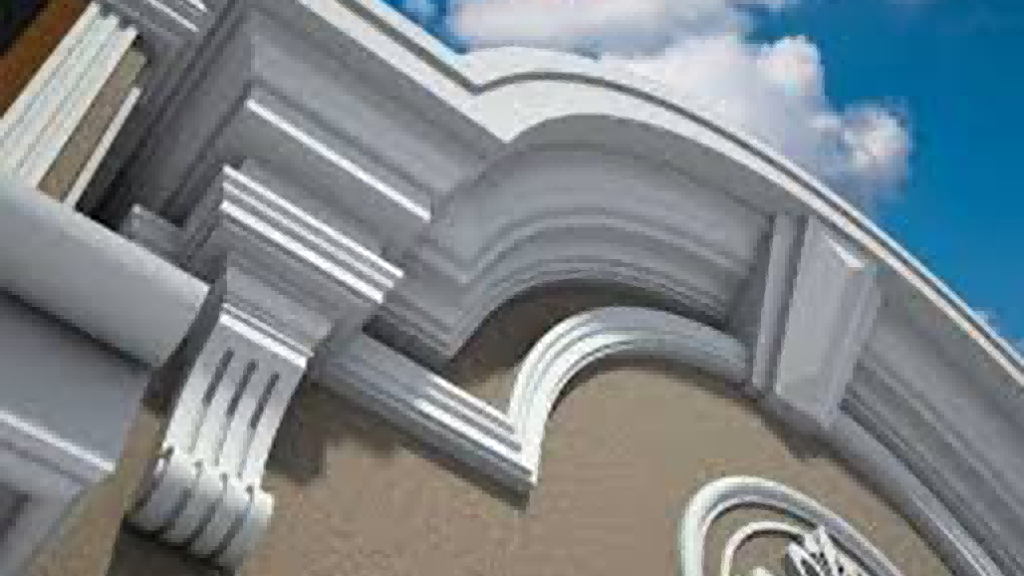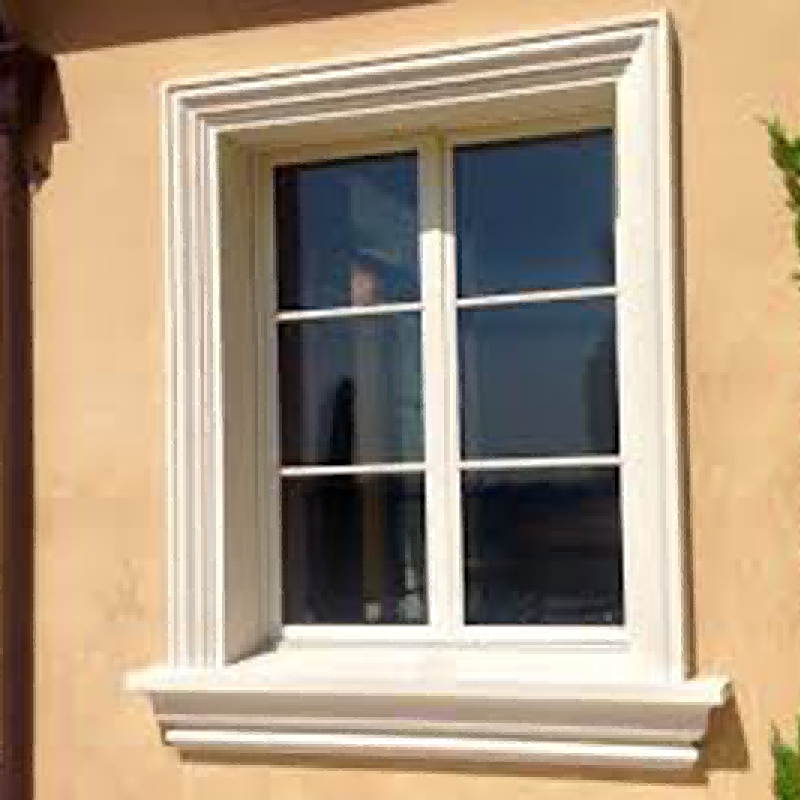Architectural Styrofoam molding is a versatile and innovative technique used in the construction and design industries to create intricate and decorative elements for buildings.
Made from expanded polystyrene (EPS) foam, these moldings are lightweight, durable, and easy to customize, making them an ideal choice for both interior and exterior applications.
What is Architectural Styrofoam Molding?

Architectural Styrofoam molding refers to decorative elements made from expanded polystyrene (EPS) foam, commonly known as Styrofoam.
These moldings are used to enhance the aesthetic appeal of buildings by adding intricate details and designs.
They can mimic traditional materials like wood, stone, and plaster but offer the advantages of being lightweight, cost-effective, and easy to install.
Properties of Architectural Styrofoam Molding
- Lightweight: EPS foam is incredibly lightweight, making it easy to handle and install.
- Durable: Despite its lightweight nature, EPS foam is highly durable and resistant to moisture, insects, and rot.
- Versatile: Can be painted, textured, or coated to match any architectural style.
- Cost-Effective: More affordable than traditional materials like wood, stone, or plaster.
- Easy to Customize: Can be easily cut and shaped to fit specific design requirements.
Benefits of Architectural Styrofoam Molding
Aesthetic Appeal
Architectural Styrofoam molding adds a touch of elegance and sophistication to any building.
It can enhance the overall design of a structure, making it look more polished and complete.
Lightweight and Easy to Install
The lightweight nature of EPS foam makes it easy to handle and install, reducing labor costs and installation time.
This is particularly beneficial for large-scale projects or hard-to-reach areas.
Durability
Architectural Styrofoam molding is highly durable and resistant to moisture, insects, and rot.
This makes it suitable for both interior and exterior applications, even in harsh weather conditions.
Cost-Effective
Compared to traditional materials like wood, stone, or plaster, architectural Styrofoam molding is more affordable.
It offers a cost-effective solution for adding decorative elements to buildings without compromising on quality or aesthetics.
Versatility
Architectural Styrofoam molding can be customized to fit any architectural style, from classical to contemporary.
It can be painted, textured, or coated to match the existing decor or create a unique design.
Applications of Architectural Styrofoam Molding

Exterior Applications
Architectural Styrofoam molding is widely used in exterior applications to enhance the aesthetic appeal of buildings.
It can be used to create cornices, window surrounds, door frames, and other decorative elements.
Cornices
Cornices are horizontal decorative moldings that crown a building or wall.
Architectural Styrofoam molding can be used to create intricate and detailed cornices that add a touch of elegance to any structure.
Window Surrounds
Window surrounds are decorative frames around windows.
Styrofoam molding can be used to create elaborate window surrounds that enhance the overall design of a building.
Door Frames
Door frames can be enhanced with architectural Styrofoam molding to create a grand and welcoming entrance.
The molding can be customized to match the architectural style of the building.
Interior Applications
Architectural Styrofoam molding is also used in interior applications to add decorative elements to walls, ceilings, and architectural features.
Crown Molding
Crown molding is used to create a seamless transition between walls and ceilings.
Styrofoam molding can be used to create intricate and detailed crown molding that adds a touch of elegance to any room.
Baseboards
Baseboards are used to cover the joint between the wall and the floor.
Architectural Styrofoam molding can be used to create decorative baseboards that enhance the overall design of a room.
Wall Panels
Wall panels can be enhanced with architectural Styrofoam molding to create a unique and decorative feature.
The molding can be customized to fit any design style, from traditional to contemporary.
Historical Restoration
Architectural Styrofoam molding is often used in historical restoration projects to replicate traditional decorative elements.
Its lightweight and customizable nature make it an ideal choice for preserving historical architecture.
Commercial Spaces
In commercial spaces, architectural Styrofoam molding is used to create a polished and professional look.
It can be used in lobbies, offices, and retail spaces to add a touch of elegance and sophistication.
Installation Process of Architectural Styrofoam Molding

Step 1: Planning and Preparation
- Measure the Area: Measure the length and height of the area where the molding will be installed. Add a few inches to each measurement to account for any mistakes or adjustments.
- Choose the Molding: Select the architectural Styrofoam molding that best fits your design needs. Consider the style, size, and texture.
- Prepare the Surface: Ensure the surface where the molding will be installed is clean, dry, and free of debris. Repair any cracks or imperfections.
Step 2: Cutting the Molding
- Measure and Mark: Measure the length of the molding needed and mark it with a pencil.
- Cut the Molding: Use a utility knife or saw to cut the Styrofoam molding to the desired length. For angled cuts, use a miter saw to ensure precise angles.
- Dry Fit the Molding: Before applying adhesive, dry fit the molding to ensure it fits properly. Make any necessary adjustments.
Step 3: Applying Adhesive
- Apply Adhesive: Using a caulking gun, apply a generous bead of construction adhesive to the back of the Styrofoam molding. Use a zigzag pattern to ensure even coverage.
- Position the Molding: Carefully position the molding on the wall or ceiling, pressing it firmly into place. Use a level to ensure it is straight.
- Secure with Fasteners: For additional support, use screws or nails to secure the molding. Be sure to countersink the fasteners slightly below the surface of the foam.
Step 4: Filling Gaps and Seams
- Apply Mesh Tape: For joints and seams, apply mesh tape to reinforce the area.
- Apply Joint Compound: Use a trowel to apply joint compound over the mesh tape and any gaps or seams. Smooth the compound evenly, feathering the edges to blend with the surrounding surface.
- Sand the Surface: Once the joint compound is dry, sand the surface smooth. Be careful not to sand too aggressively, as this can damage the foam.
Step 5: Priming and Painting
- Apply Primer: Apply a coat of primer suitable for foam and stucco surfaces. This will help the paint adhere better and provide a uniform finish.
- Paint the Molding: Once the primer is dry, apply paint using a brush or roller. Choose a paint color that matches your decor. For a textured finish, consider using a stucco paint or applying a texture coat.
Step 6: Sealing and Finishing
- Caulk the Edges: Apply caulk to the edges and joints of the molding to seal any gaps and create a seamless look.
- Touch Up: Inspect the molding for any imperfections and touch up with paint or joint compound as needed.
- Clean Up: Remove any debris and clean your tools and work area.
Tips for Successful Installation

Choose the Right Adhesive
Select a high-quality construction adhesive that is specifically designed for foam and stucco. This will ensure a strong and durable bond.
Use a Level
Always use a level to ensure the architectural Styrofoam molding is installed straight. This will prevent any uneven or crooked lines that can detract from the overall appearance.
Reinforce Joints
Use mesh tape and joint compound to reinforce joints and seams. This will create a smooth and seamless finish, preventing cracks and gaps.
Sand Smoothly
When sanding the joint compound, use fine-grit sandpaper and sand gently. This will help achieve a smooth finish without damaging the foam.
Apply Multiple Coats
For the best results, apply multiple coats of primer and paint. This will ensure even coverage and a professional-looking finish.
Conclusion

Architectural Styrofoam molding is a versatile and innovative solution for enhancing the aesthetic appeal of buildings.
Its lightweight, durable, and cost-effective nature makes it an ideal choice for both interior and exterior applications.
By understanding the benefits, applications, and installation process of architectural Styrofoam molding, you can make informed decisions that enhance the beauty and value of your property.
As the industry continues to evolve, staying informed about the latest trends and advancements in architectural Styrofoam molding will be crucial for maintaining a competitive edge and meeting the demands of modern consumers.
Whether you are a homeowner, designer, or contractor, architectural Styrofoam molding offers endless possibilities for creating beautiful and durable decorative elements.
In conclusion, architectural Styrofoam molding is more than just a decorative element; it is a versatile and valuable tool for enhancing the aesthetic appeal of any space.
By mastering the process of installation and finishing, you can bring your design ideas to life and produce functional and aesthetically pleasing decorative elements.
Whether you are enhancing a residential home, a commercial space, or a historical building, architectural Styrofoam molding offers a cost-effective and efficient solution.
Additional Considerations
Environmental Impact
Consider the environmental impact of the materials used in architectural Styrofoam molding.
Opt for eco-friendly adhesives, paints, and primers that are low in volatile organic compounds (VOCs).
Proper disposal of waste materials is also essential to minimize environmental harm.
Safety Precautions
Always prioritize safety when working with adhesives, paints, and tools.
Wear protective gear, such as gloves, goggles, and masks, to protect against fumes and skin contact.
Ensure your workspace is well-ventilated and free from flammable materials.
Cost Considerations
The cost of materials and tools for architectural Styrofoam molding can vary widely.
Plan your budget carefully and consider the long-term benefits of investing in high-quality materials and tools.
While initial costs may be higher, durable and reliable materials can save money in the long run by reducing the need for frequent replacements and repairs.
Continuous Learning
Architectural Styrofoam molding is a skill that improves with practice and experience.
Stay updated with the latest techniques, materials, and tools by attending workshops, reading industry publications, and networking with other professionals.
Continuous learning and experimentation can lead to innovative and improved installation methods.
